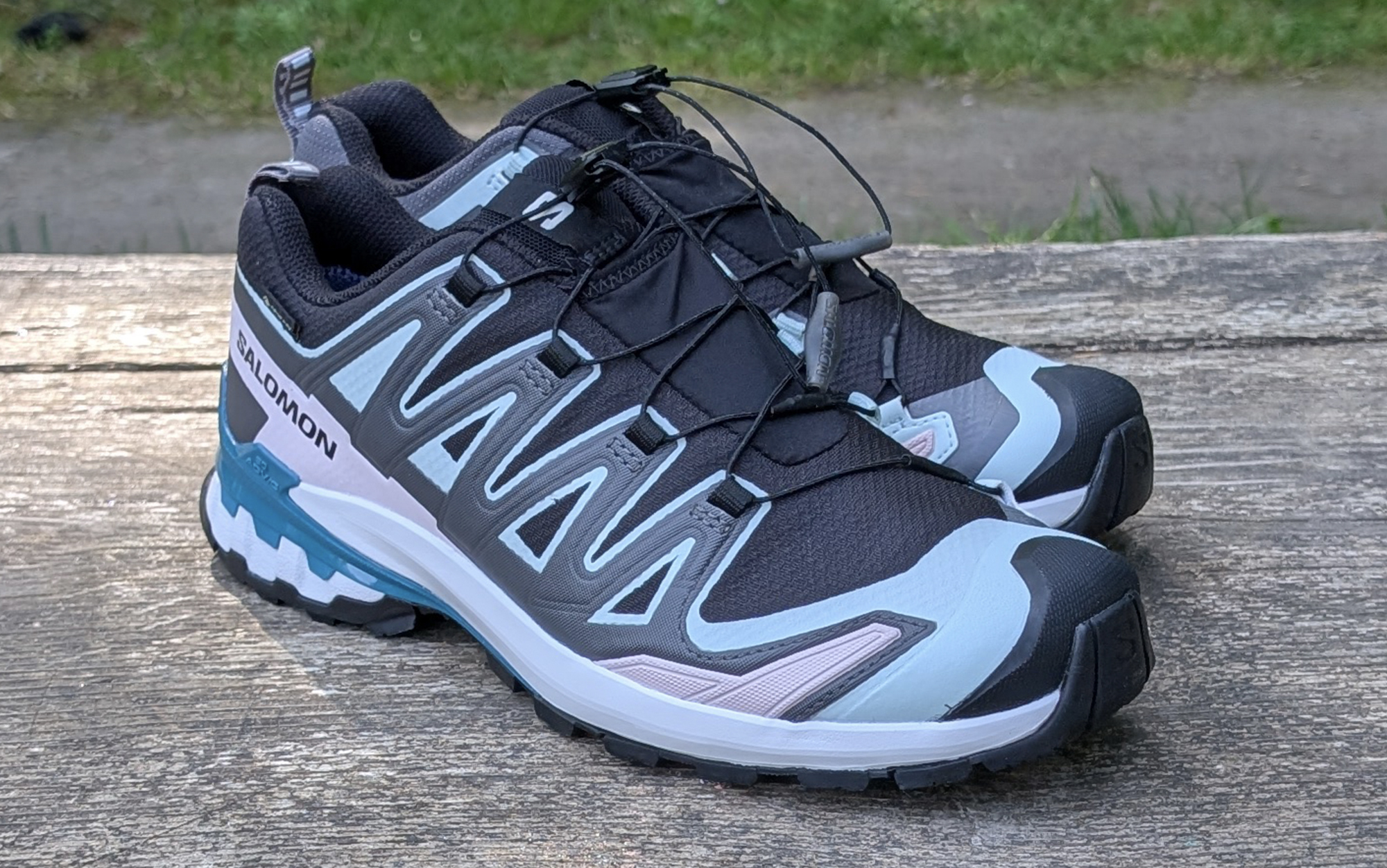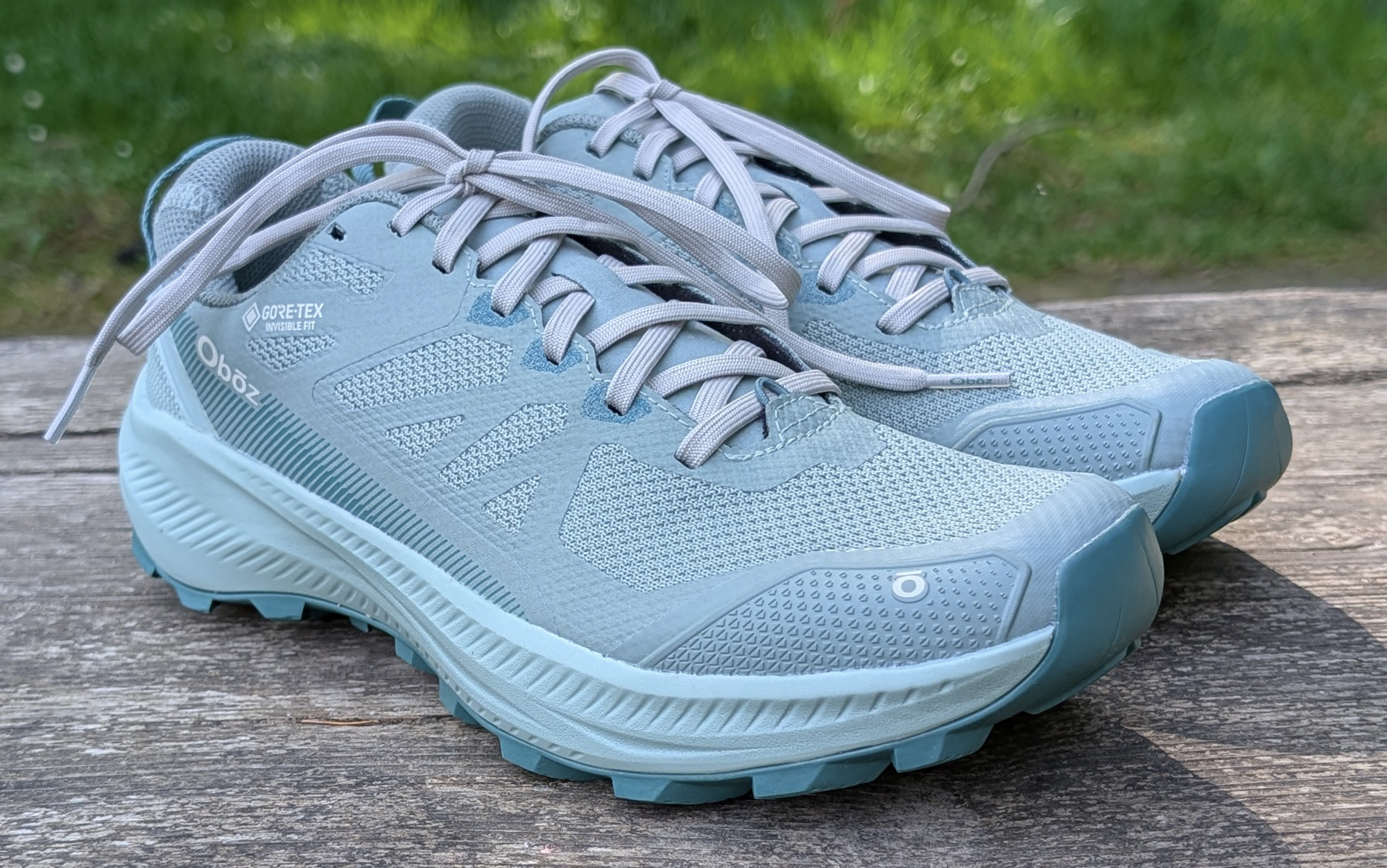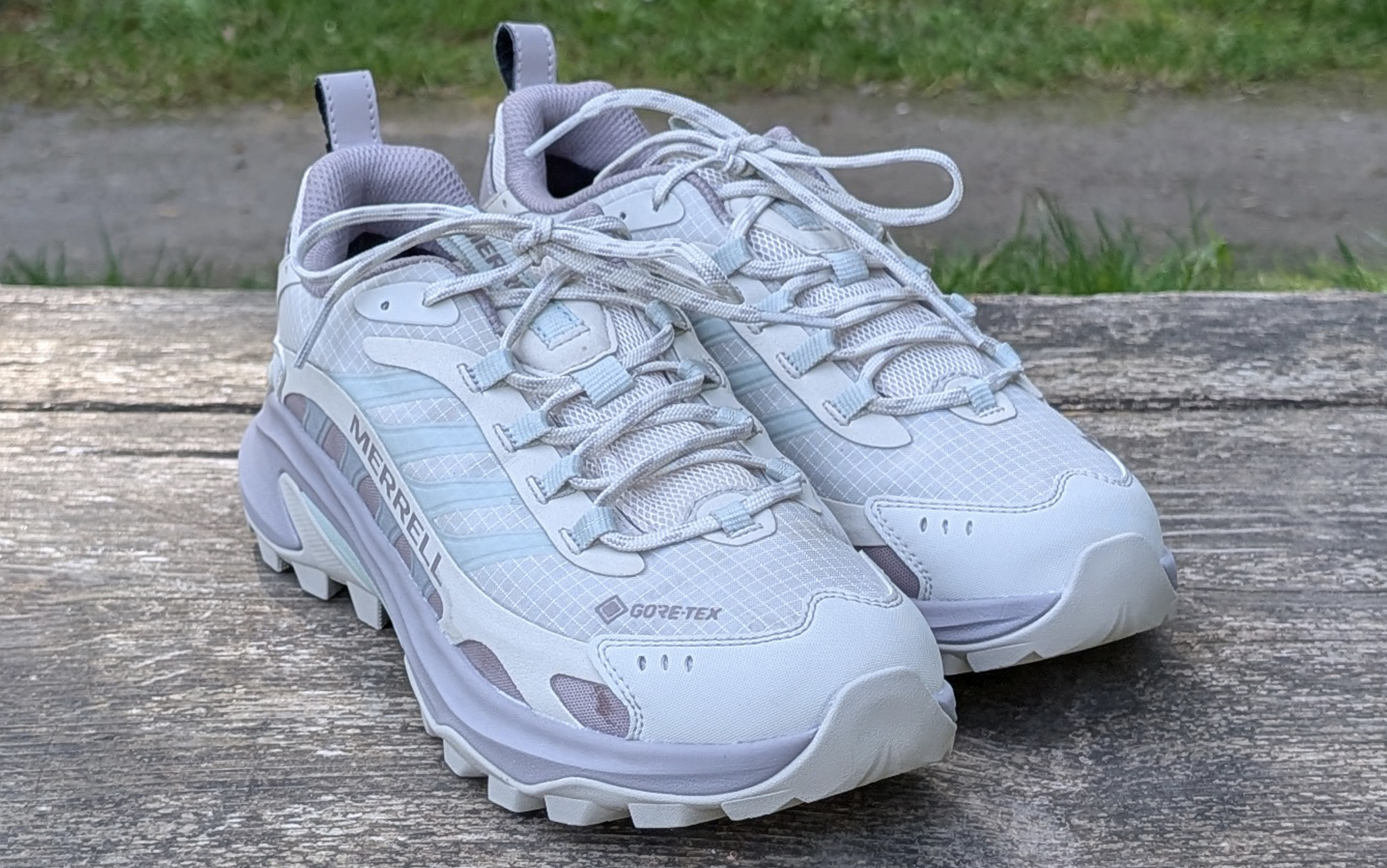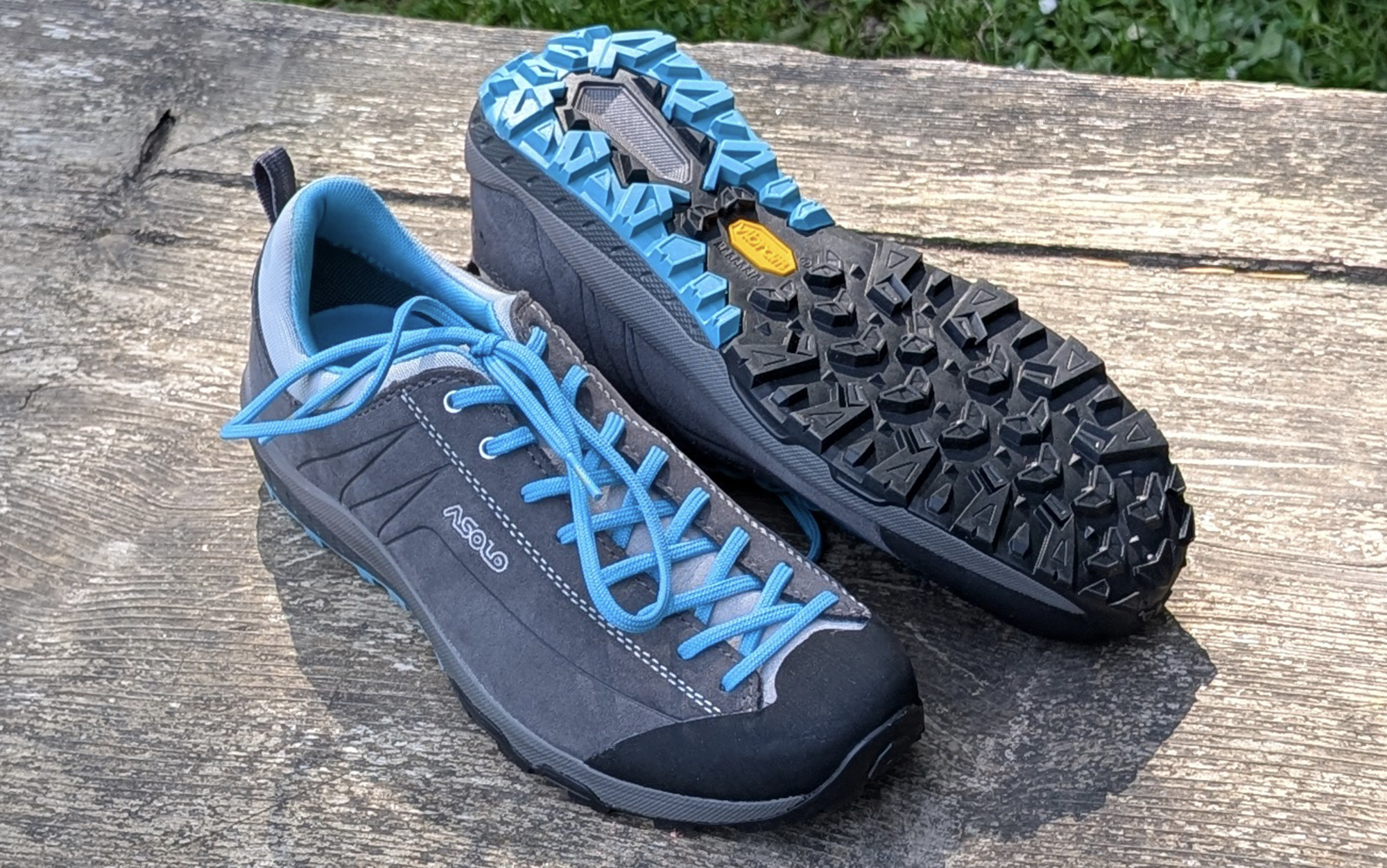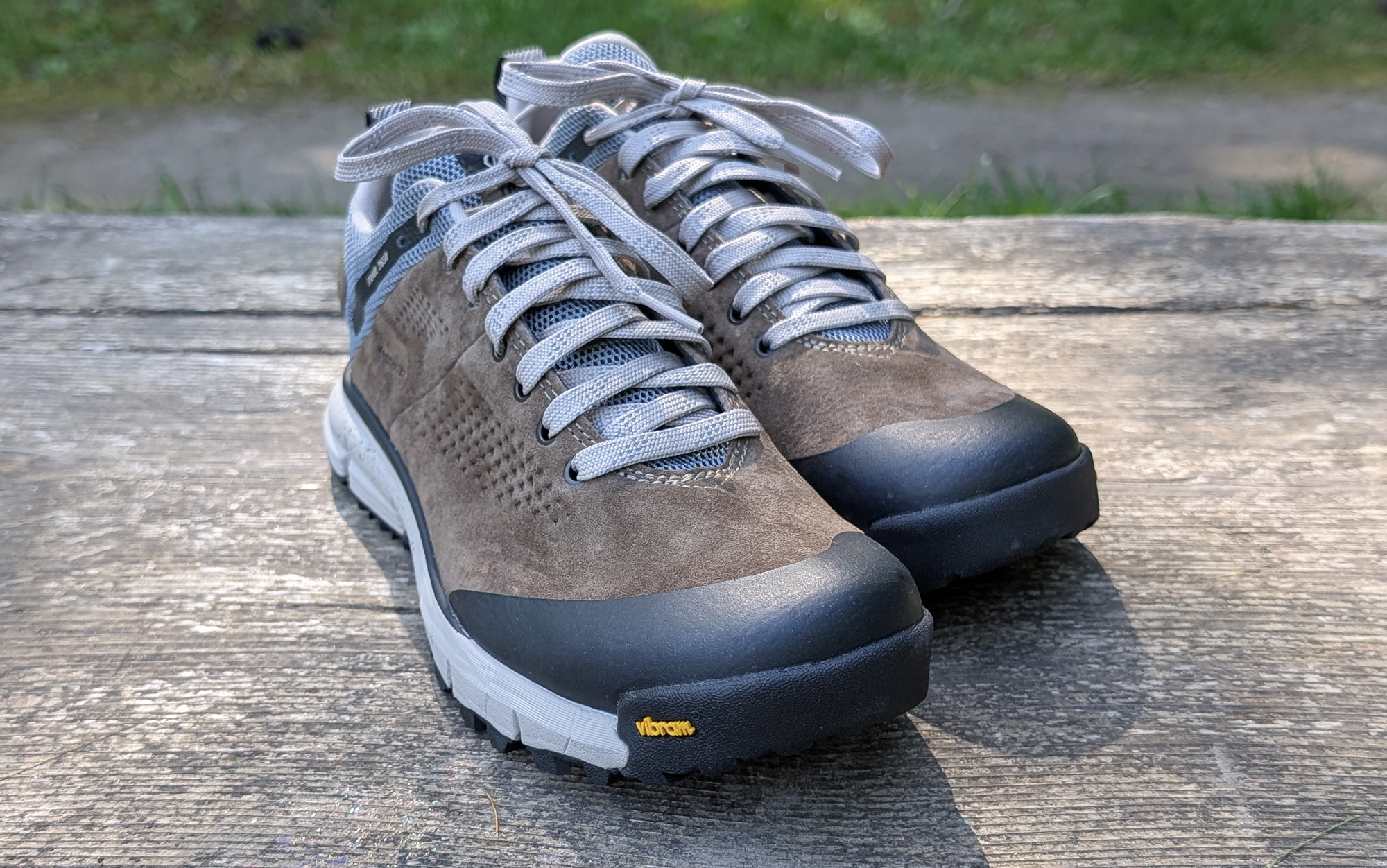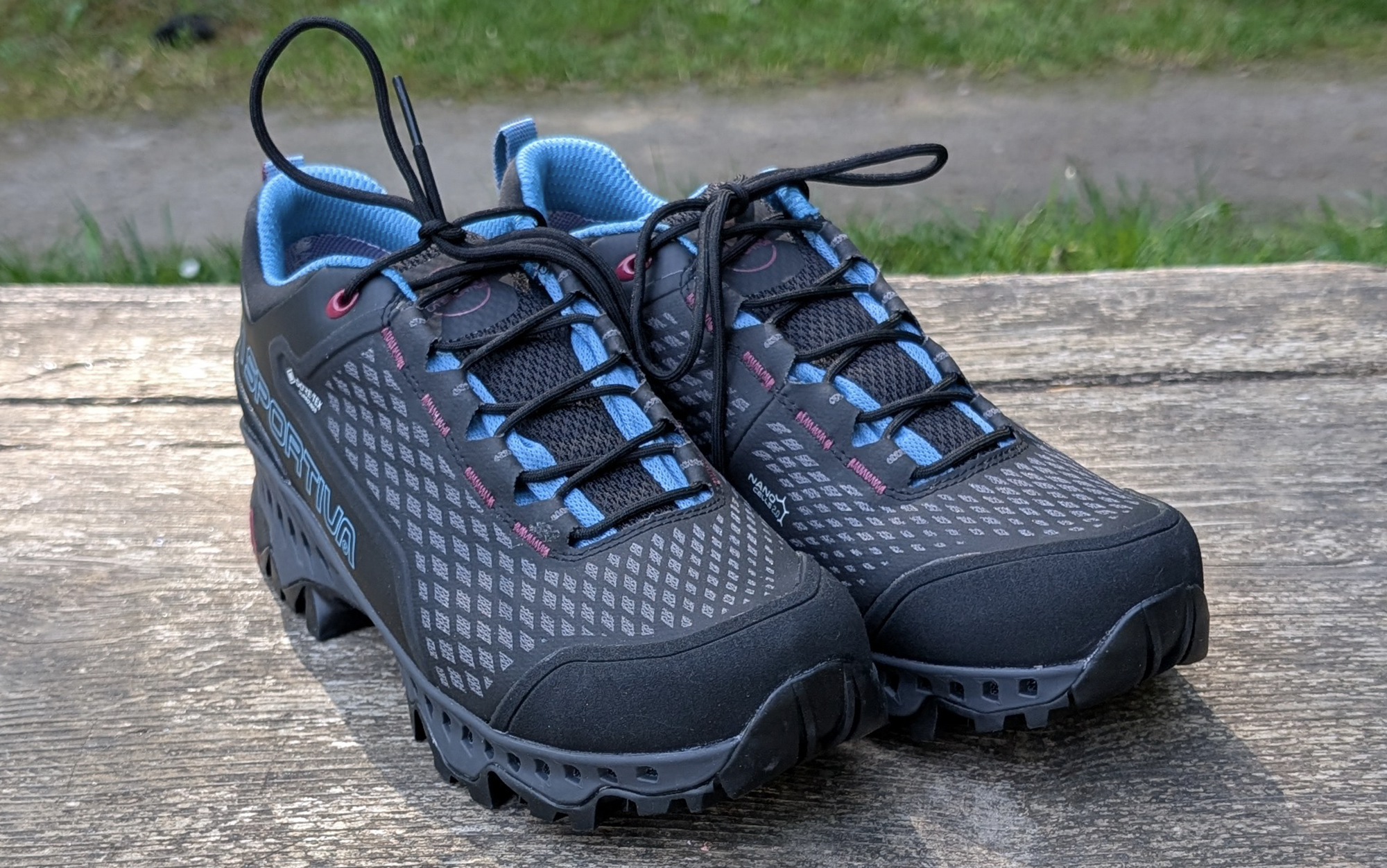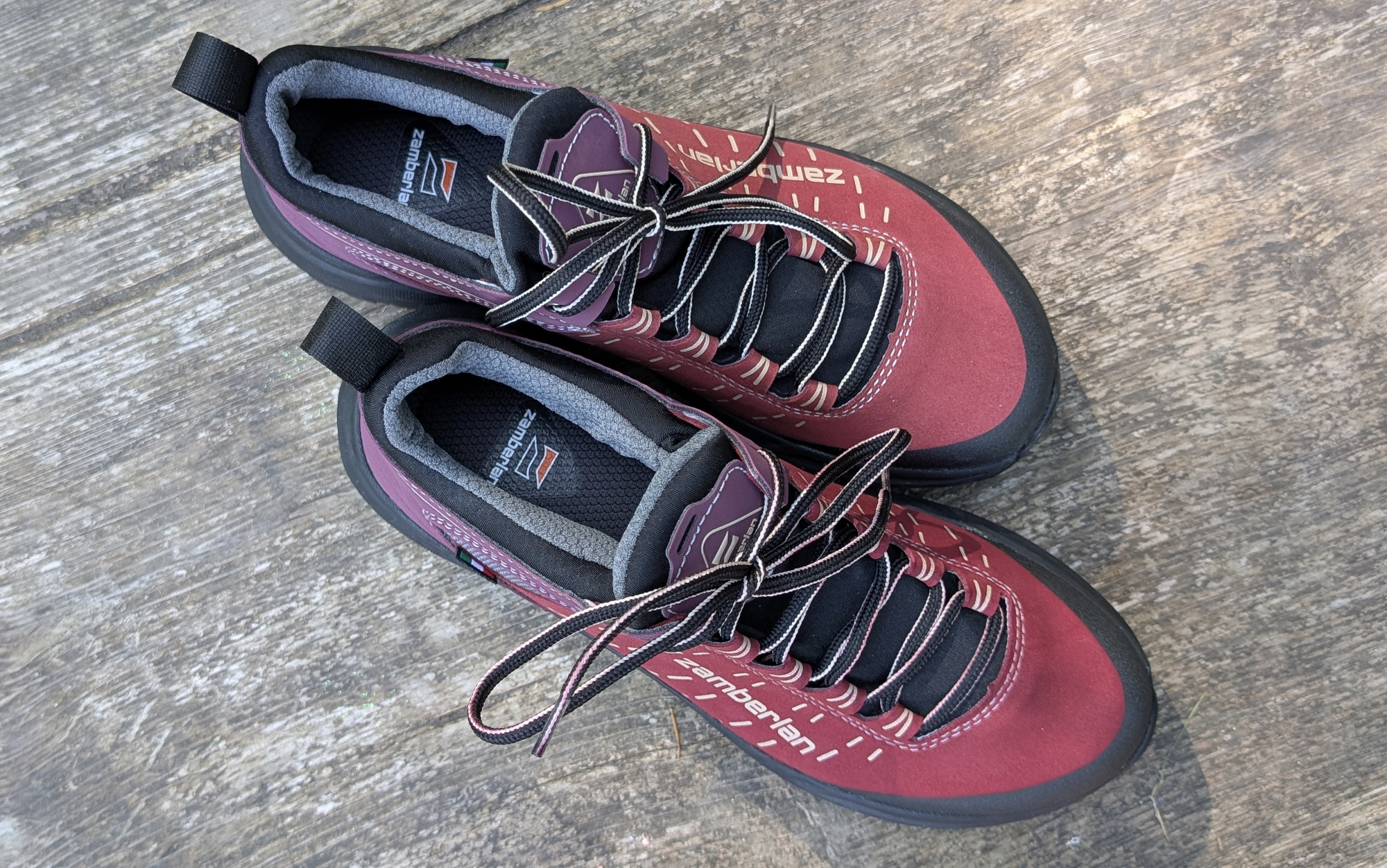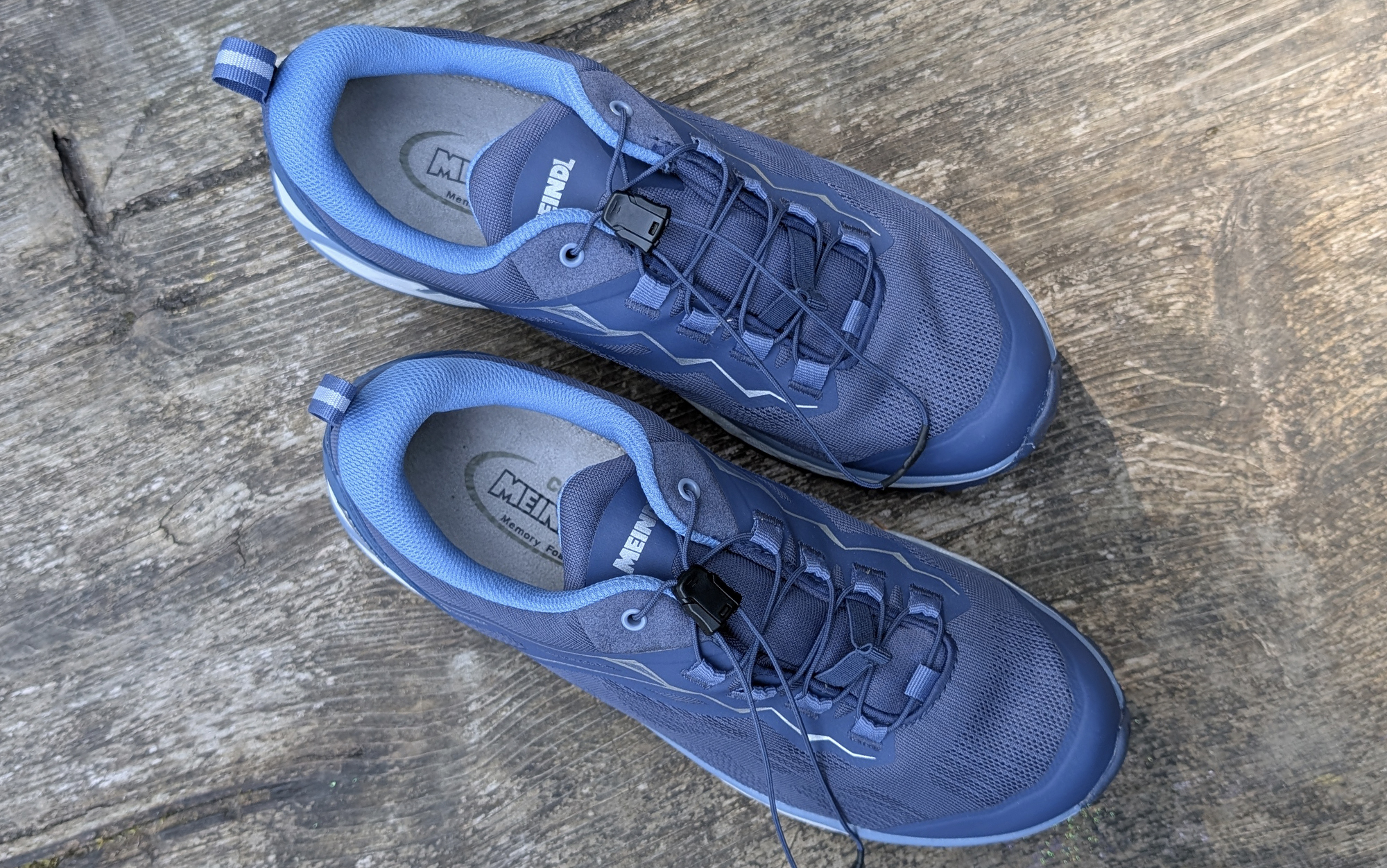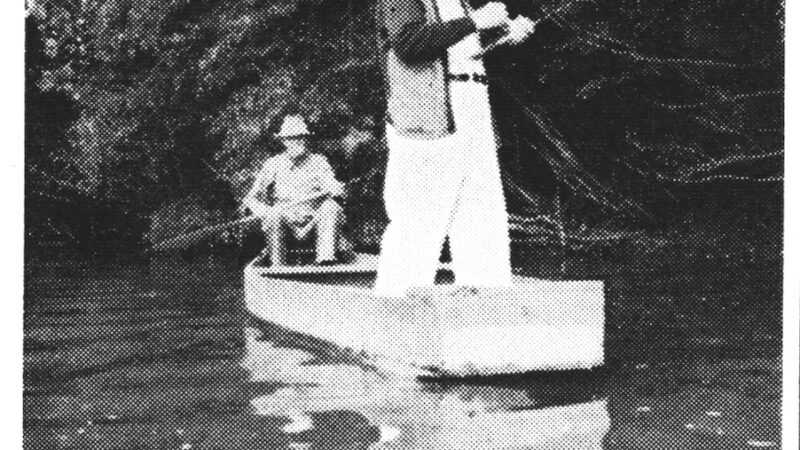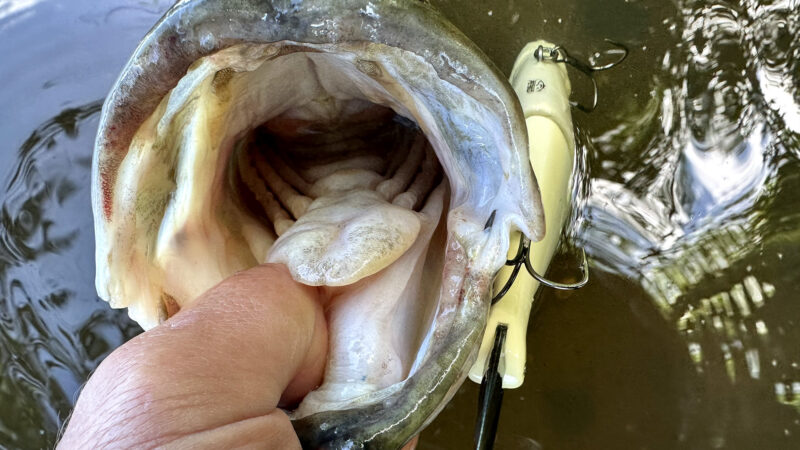The Best Waterproof Hiking Shoes of 2025, Tested and Reviewed
We may earn revenue from the products available on this page and participate in affiliate programs. Learn More ›
Everyone with waterproof hiking shoes knows a secret: rainy days are the best for hiking because the trails are nearly empty. You can hike for miles without running into another soul. It’s not too hot on those uphill climbs. And when the sun does finally peek out from behind the clouds, the light twinkling through the trees, the smell of fresh earth rising with the mist, is better than any vista. If you want a piece of this hiking heaven, you’ll need one of the best rain jackets and pants, a cover for the best daypack, and a pair of the best waterproof hiking shoes: Here are my top picks.
| Best Overall | Best Value | Most Comfortable | Lightest | Best for Scrambling | |||||
|---|---|---|---|---|---|---|---|---|---|
| Salomon XA Pro 3D V9 GTX | Oboz Katabatic LT Low GTX | Hoka Anacapa 2 Low GTX | Merrell Moab Speed 2 GTX | Asolo Space GV ML | Danner Trail 2650 GTX | Oboz Sawtooth Low B-Dry Waterproof | La Sportiva Spire GTX | Zamberlan Circe GTX Low | Meindl Power Walker Lady 3.0 |
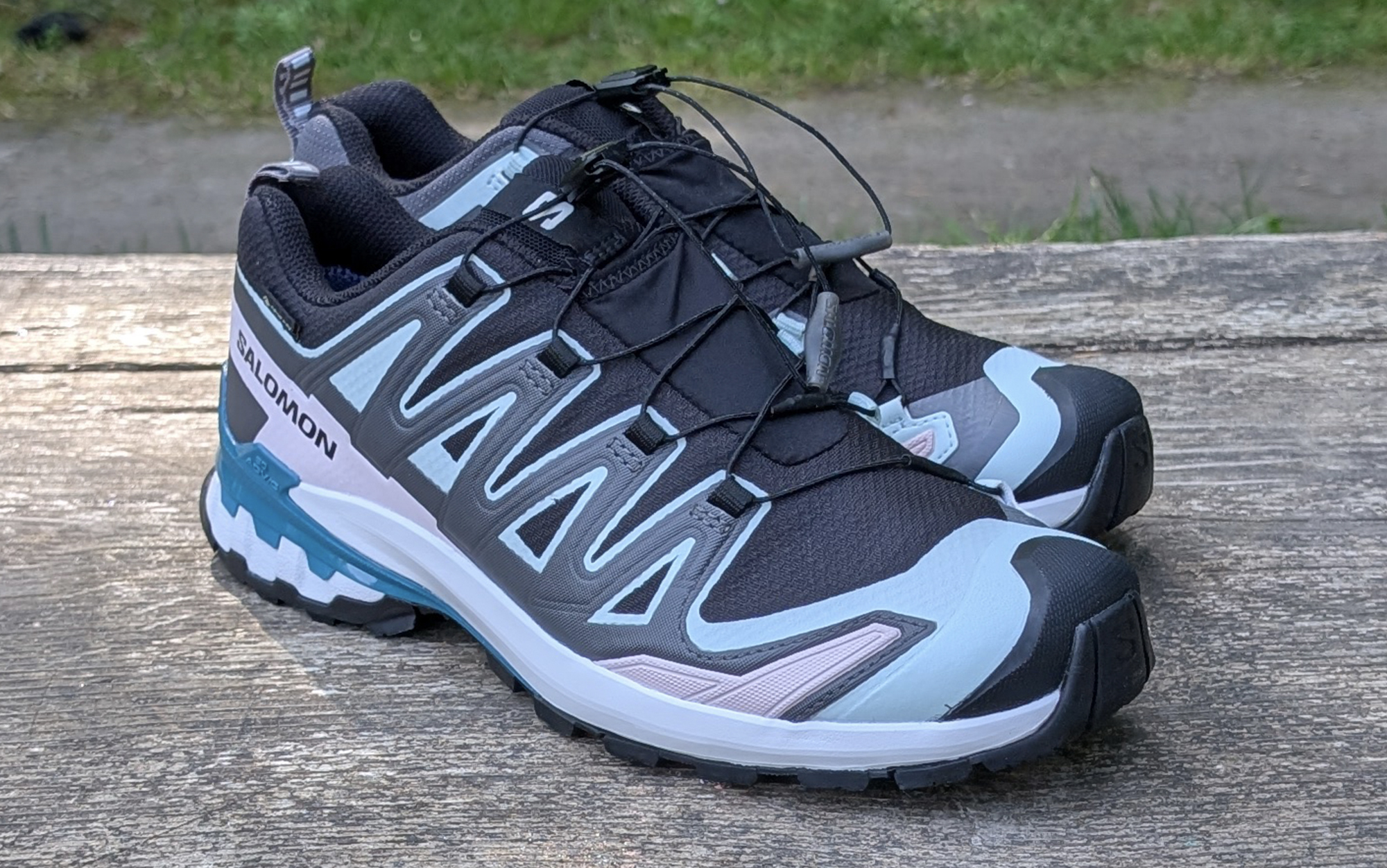 |
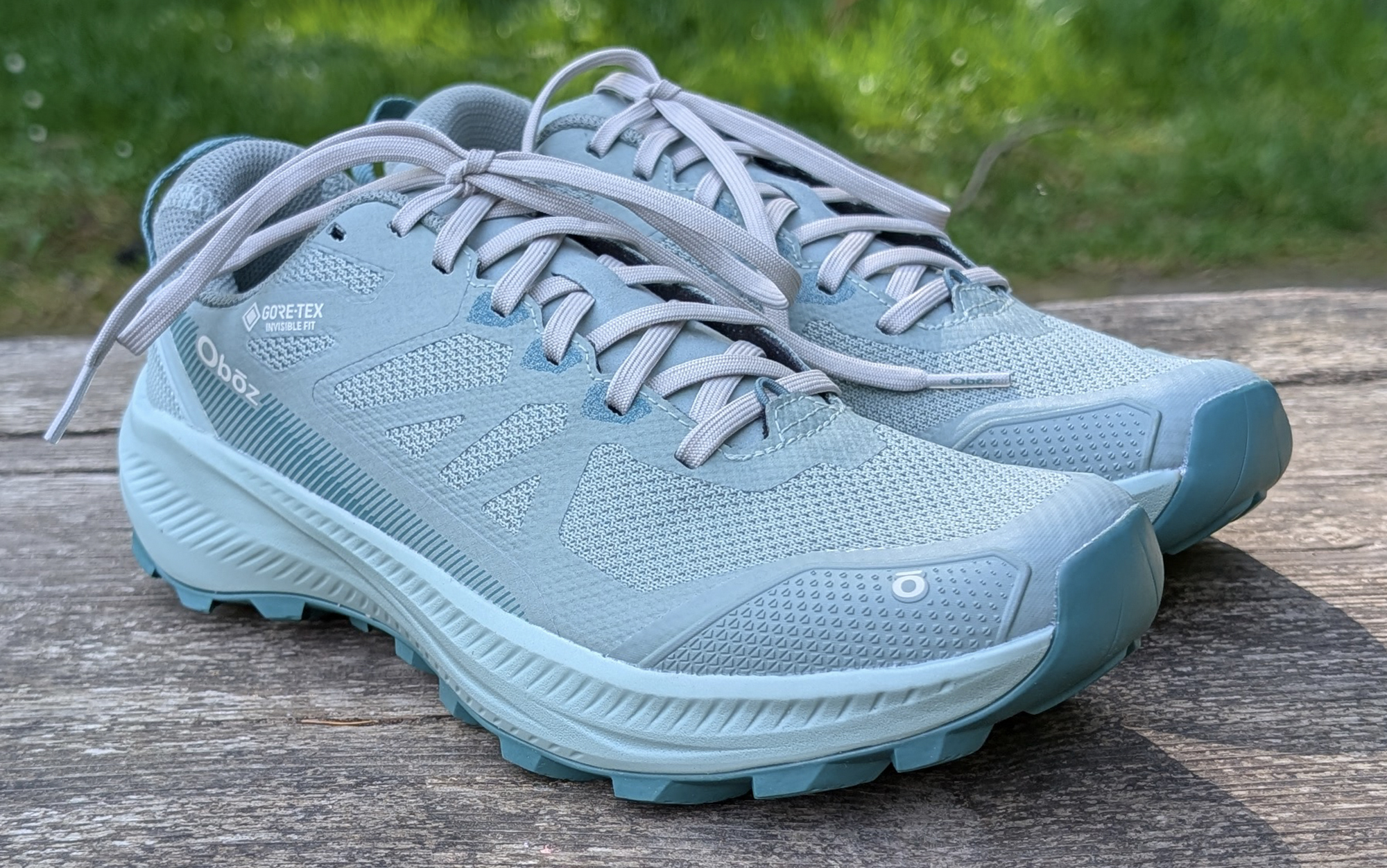 |
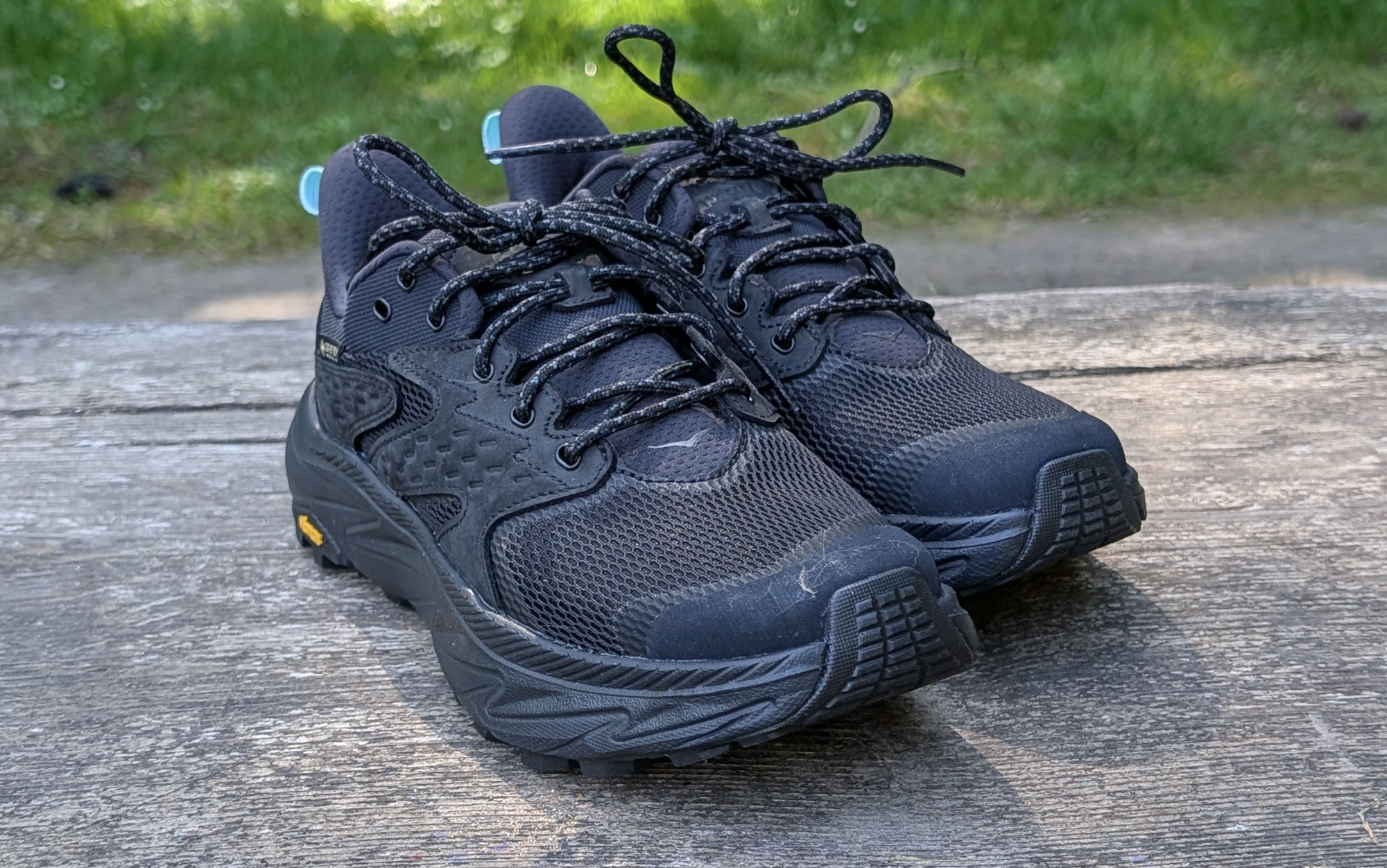 |
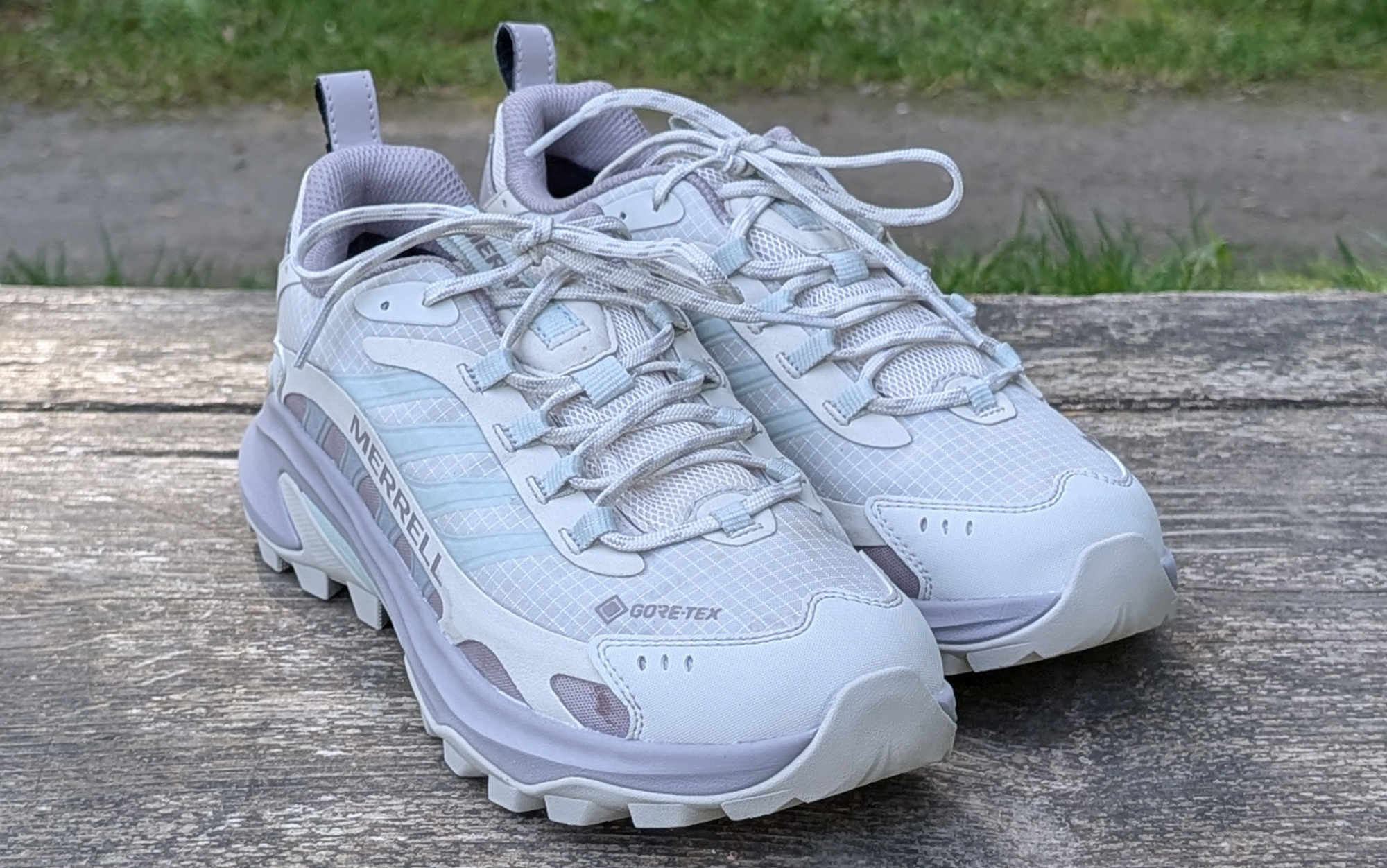 |
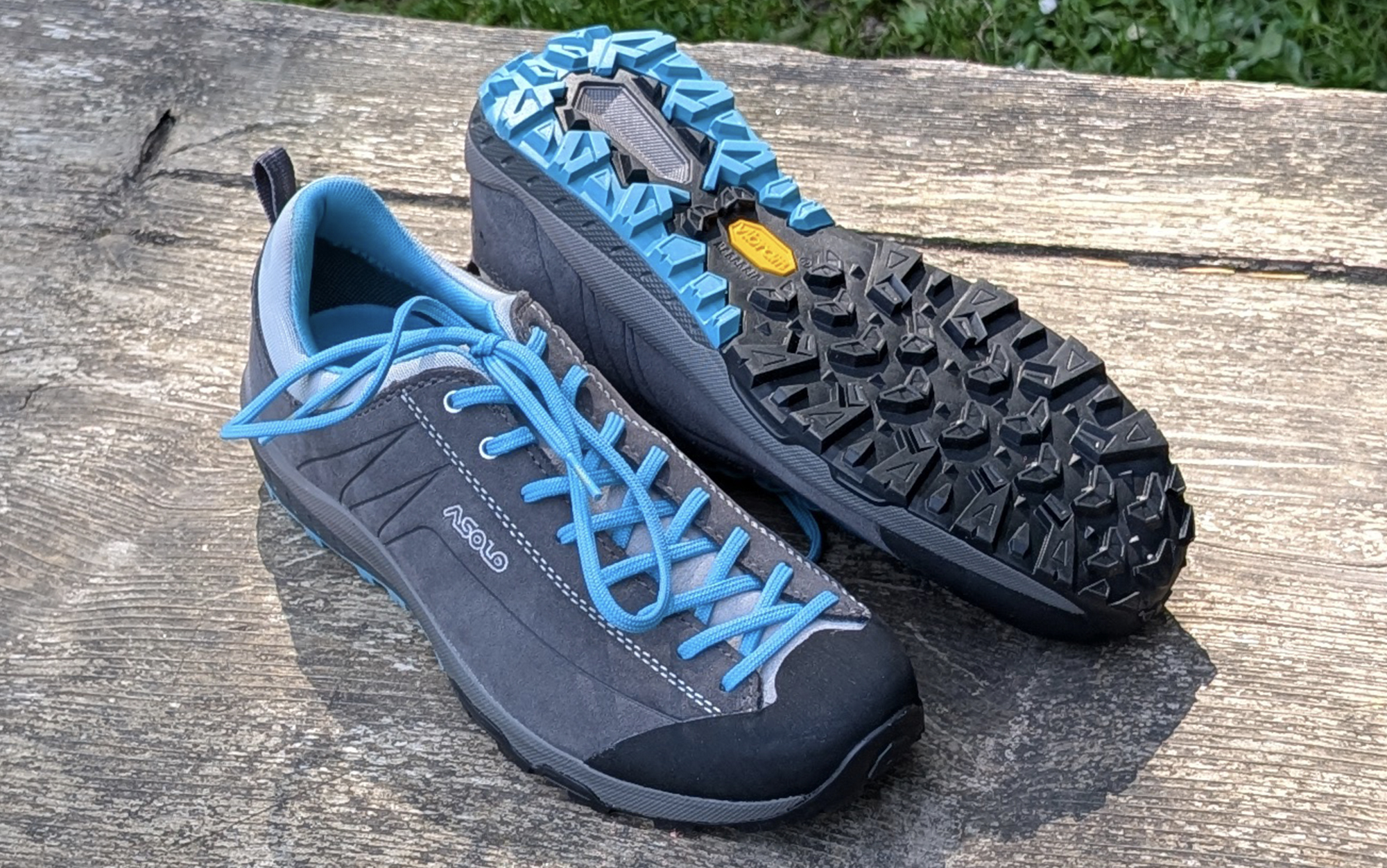 |
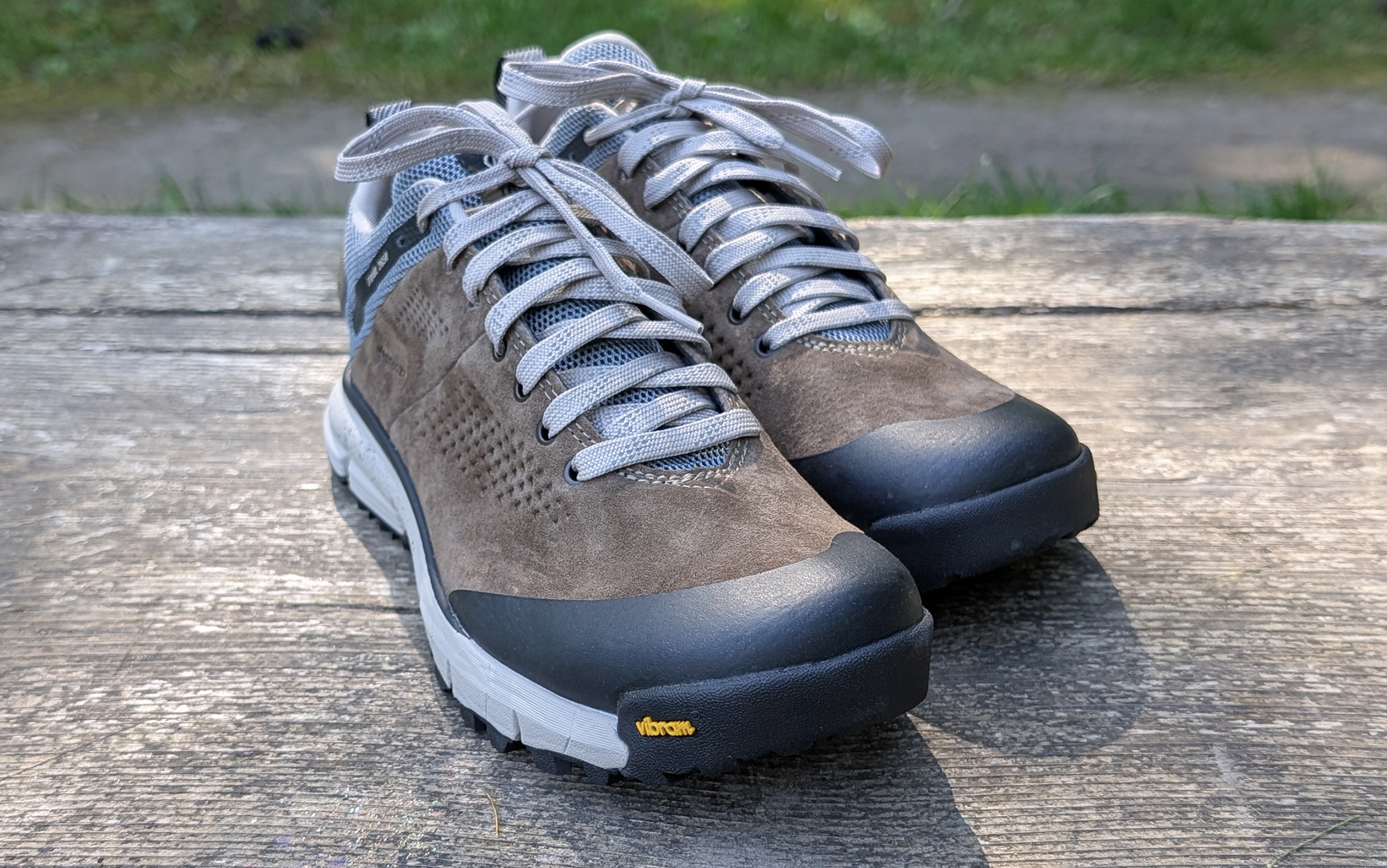 |
 |
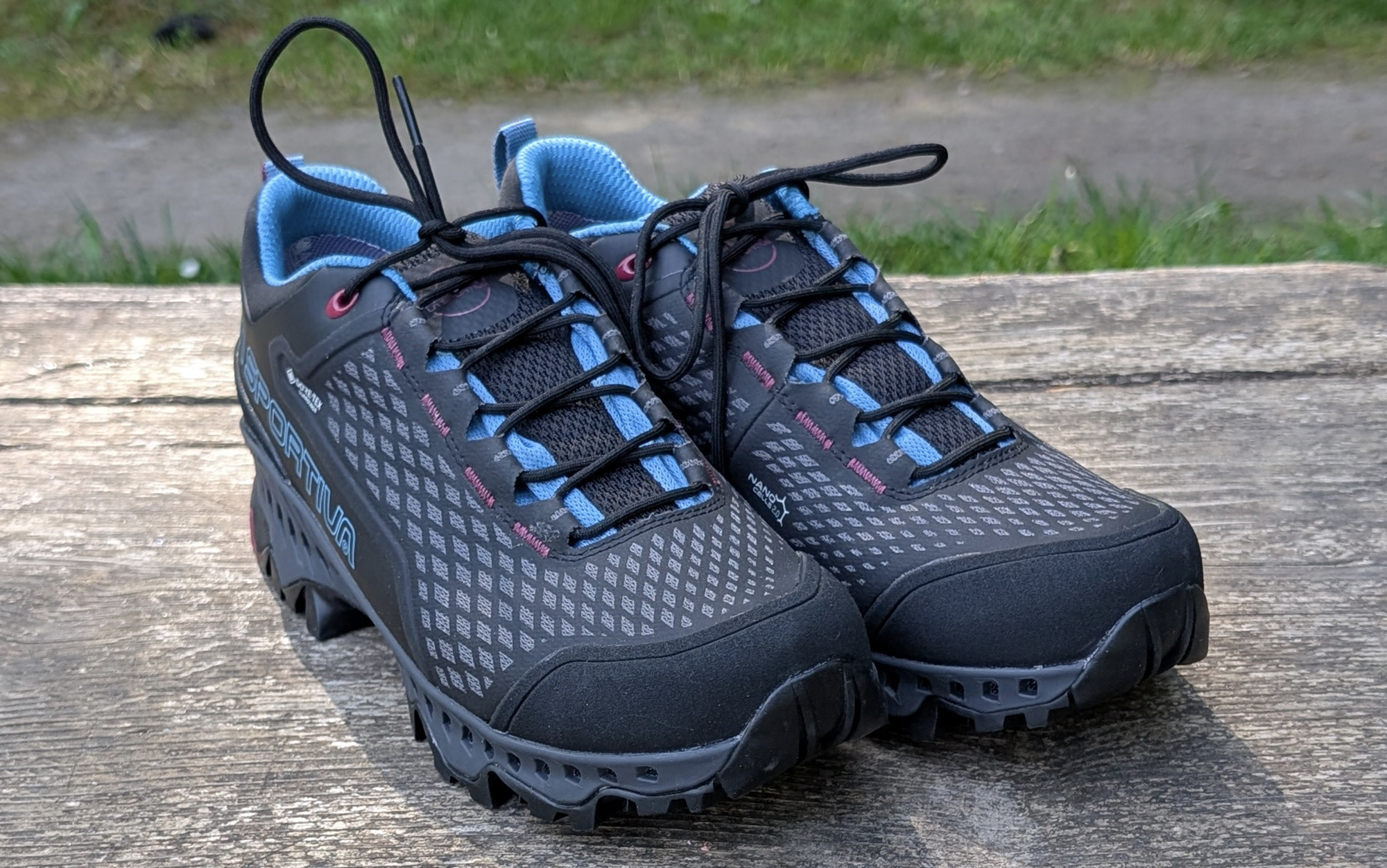 |
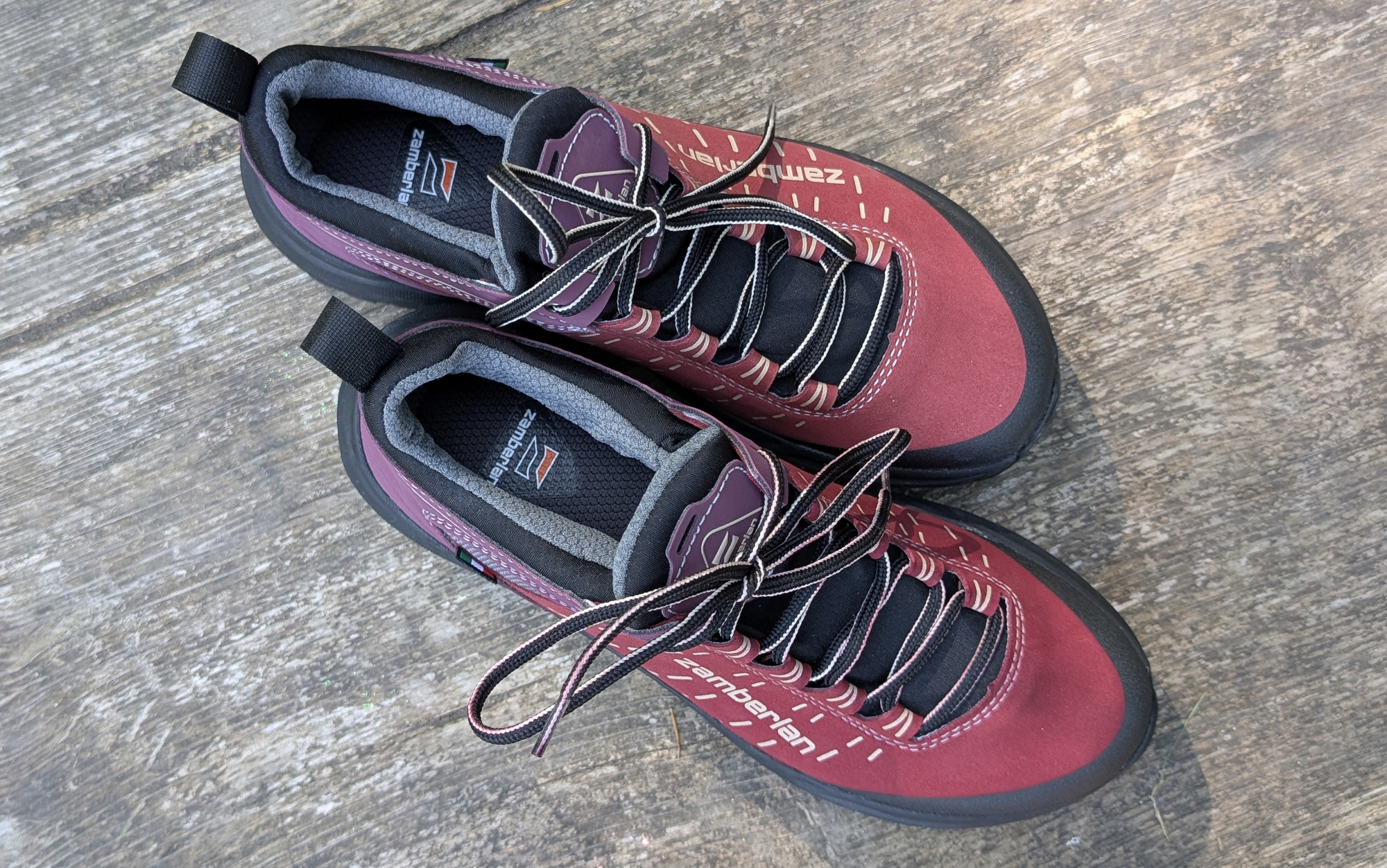 |
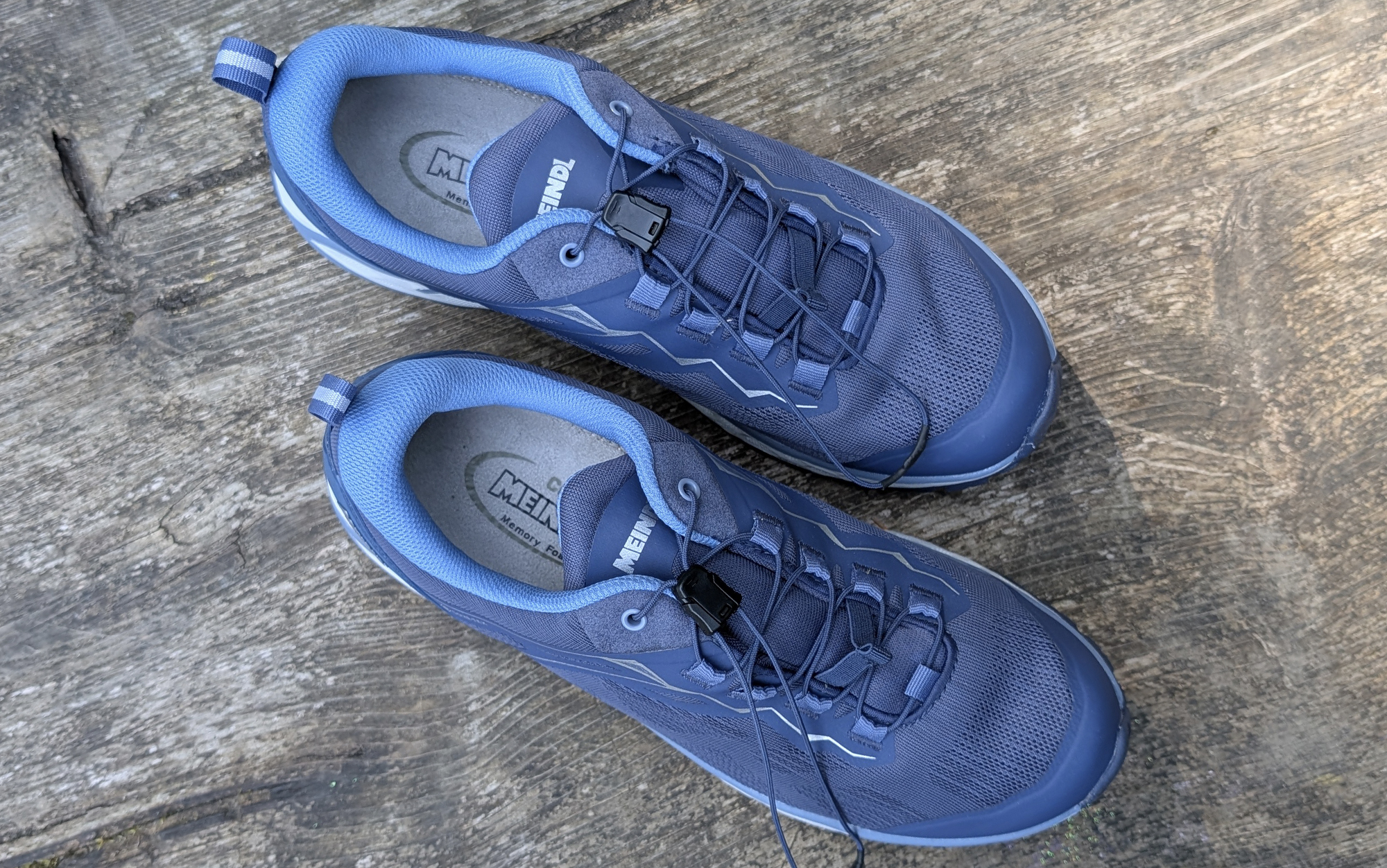 |
 |
 |
 |
 |
 |
 |
 |
 |
||
 |
 |
 |
 |
 |
 |
 |
 |
 |
 |
| Read the Review | Read the Review | Read the Review | Read the Review | Read the Review | Read the Review | Read the Review | Read the Review | Read the Review | Read the Review |
The Best Waterproof Hiking Shoes: My Top Picks
Best Overall: Salomon XA Pro 3D V9 GTX
Pros
- Dries quickly
- Not too expensive
Cons
- Not suitable for individuals who need or prefer low arch support
Key Features
-
Available Sizes:
Men’s 7-14 (wides available); women’s 5-11 -
Fit:
In-between -
Arch Support:
High -
Runs true to size
Test Results
-
Price:
$160 -
Weight of One Shoe:
12.6 ounces -
PFAS free -
Soak Test:
Pass -
Dry Test:
34 hours
Of all the waterproof hiking shoes I tested, the Salomon XA Pro 3D V9 GTX (mouthful, anyone?) hit the sweet spot of technical performance and a fit that should work for most people. I was especially impressed by its fast dry time and comparatively affordable price point.
Increasingly footwear is falling into one of two camps: traditional, locked-in footwear that keeps your feet from sliding around inside your shoes and spacious designs that reflect the natural movement idea that feet should be allowed to do what feet do. Technical fit is favored by individuals who are scrambling, while natural fits are preferred by individuals who have spent time strengthening their feet. Most people should look for a shoe that falls in between these two camps — like the Salomon XA Pro 3D V9 GTX— as hiking is neither the time to overly challenge your foot strength nor let it atrophy.
Read Next: The Anatomy of a Shoe
This one runs true to size, but has a high degree of arch support, which may aggravate individuals who naturally have lower arches.
Best Value: Oboz Katabatic LT Low GTX
Pros
- One of the least expensive shoes I tested
- Lightweight
Cons
- Locked-in feel may be uncomfortable to some hikers
Key Features
-
Available Sizes:
Men’s 8-14 (wides available); 5-12 (wides available) -
Fit:
Technical -
Arch Support:
Low -
Runs true to size
Test Results
-
Price:
$145 -
Weight of One Shoe:
11.5 ounces -
PFAS free -
Soak Test:
Pass -
Dry Test:
46 hours
It is unbelievable how expensive footwear is these days. Spending upwards of $100 on a pair of waterproof hiking shoes is virtually unavoidable, with some closing in on $200. So I appreciated that the Oboz Katabatic kept costs under $150 while still delivering on the technical side of waterproof hiking shoes.
This pair took longer to dry than some of the lighter weight waterproof hiking shoes in this story, but it wasn’t the worst performer in this test on that metric. And I appreciated that it ran true to size with a low arch support, as it has the best chance of fitting the widest range of hikers. Note that this one is more of a technical fit than others on this list, so if you’d rather splay your toes when you are hiking, go with another choice, like the Hoka Anacapa 2 Low GTX.
Most Comfortable: Hoka Anacapa 2 Low GTX
Pros
- Cushioned and comfortable
- Forgiving fit should work for most feet
- Very fast drying
Cons
- Not a good fit for narrow feet
- Bulky look is not aesthetically pleasing
Key Features
-
Available Sizes:
Men’s 7-15 (wides available); 5-11 (wides available) -
Fit:
Natural fit -
Arch Support:
Low -
Runs slightly large
Test Results
-
Price:
$180 -
Weight of One Shoe:
13.4 ounces -
PFAS free -
Soak Test:
Pass -
Dry Test:
24 hours
Hoka’s comfort is already well-known among hikers, and the Hoka Anacapa 2 Low GTX is no exception to that. This is a very cushioned shoe that will protect your feet from feeling any discomfort underfoot. I also appreciated that this hiking shoe has a comparatively wider, more natural fit. You can definitely splay out your toes, which is helpful for balance and activating your arch, (something the low arch support here will only minimally interfere with). The wider fit is not only a boon to individuals with wider feet, it is also beneficial to individuals who like to kick out long on the days on the trail, which can lead to foot swell.
Read Next: Hoka Anacapa 2 Review
Like all Hokas, the Anacapa 2 has a very beefy look and feel to it. If you aren’t used to these shoes, it can be disorienting at first to wear them. For plenty of well-maintained, low-key trails, this won’t be a problem. But if you plan to do anything technical this shoe is not the right choice. It has one of the more pronounced toe springs in my test: this is great if you lack big toe mobility, but the corollary is that it can lead to less flexibility in your big toe if you wear it habitually. It also has a chunky back outsole, which can impact your gait.
Even though the Hoka Anacapa 2 wasn’t the lightest shoe in my test, it dried faster than anything else, an impressive result.
Lightest: Merrell Moab Speed 2 GTX
Pros
- Very lightweight
- Should fit most people
Cons
- Took longer to dry than other shoes in my test
Key Features
-
Available Sizes:
Men’s 7-15; women’s 5-11 -
Fit:
In-between fit -
Arch Support:
Low -
Runs true to size
Test Results
-
Price:
$170 -
Weight of One Shoe:
11.3 ounces -
PFAS free -
Soak Test:
Pass -
Dry Test:
48 hours
I was surprised that the Merrell Moab Speed 2 GTX, the lightest shoe in my test, was also one of the slowest to dry. But when I checked the relative weight of each shoe — the one that had been subjected to my dry test and the control shoe — I found that there was a 0.3 ounce difference. This suggests that while this hiking shoe felt dry on the inside, it was actually holding onto a non-negligible amount of moisture. That helps explain, in part, why this one took so long to dry (the second longest in my test), and suggests that if you have unusually sweaty feet, this is probably not the right choice for you.
But a lightweight shoe is great for all hikers, as it will reduce foot fatigue on the long haul. Simply put, the less weight you have to move through the gait cycle, the more energy you’ll have to hike longer.
Best for Scrambling: Asolo Space GV ML
Pros
- Streamlined profile boosts foot control
- Lightweight
- Vibram Megagrip outsole
Cons
- Could be uncomfortable for longer periods of time
Key Features
-
Available Sizes:
Men’s 8-13; women’s 6-10.5 -
Fit:
Technical -
Arch Support:
Low -
Runs true to size
Test Results
-
Price:
$180 -
Weight of One Shoe:
11.8 ounces -
PFAS free -
Soak Test:
Pass -
Dry Test:
42 hours
If you are planning to tackle more technical terrain, such as rock scrambles or scree, a shoe like the Hoka Anacapa is not the best choice. The comparatively looser fit means that your foot is that much more likely to slip, and your ankle that much more likely to twist with every step. A better choice would be the Asolo Space GV ML. This shoe had one of the more technical fits of what I looked at, locking in the toes, midfoot, and heel securely and comfortably. I also appreciated that its laces extended farther down is typical, giving you that much more control over the shoe’s fit.
This one also has superior technical details as well, including a robust toeguard and the Vibram Megagrip outsole. I’ve used this particular outsole on several shoes now and have always come away impressed with how much better traction it provides on steep terrain.
The Best Waterproof Hiking Shoes: The Rest of the Field
Danner Trail 2650 GTX
Pros
- Dries quickly
- Lightweight
- Vibram Megagrip outsole
Cons
- A little pricey
Key Features
-
Available Sizes:
Men’s 7-14 (some sizes available in wide); women’s 5-11 -
Fit:
Technical -
Arch Support:
Low -
Runs small
Test Results
-
Price:
$190 -
Weight of One Shoe:
11.6 ounces -
PFAS free -
Soak Test:
Pass -
Dry Test:
32 hours
The Danner Trail 2650 GTX is an excellent waterproof hiking shoe. It was the second fastest drying shoe in my test, albeit taking eight hours longer than the Hoka Anacapa, is very lightweight, and had no problems whatsoever with the soak test. Its fit is on the technical side, and it features a Vibram Megagrip outsole to match. If I was going to quibble with anything, it would just be that this is a pricier shoe than some of the other picks on this list, including my best overall and best value picks.
Oboz Sawtooth Low B-Dry Waterproof
Pros
- Most affordable in my test
Cons
- Somewhat heavy
- Second longest drying time
- Narrow profile and high arch support limits who can comfortably wear this shoe
Key Features
-
Available Sizes:
Men’s 7-15 (wides available); women’s -
Fit:
Technical -
Arch Support:
High -
Runs narrow
Test Results
-
Price:
$140 -
Weight of One Shoe:
15.2 ounces -
PFAS free -
Soak Test:
Pass -
Dry Test:
49 hours
If you have a narrow foot and a high arch, one waterproof hiking shoe to consider is the Oboz Sawtooth Low B-Dry Waterproof. This was one of the only waterproof hiking shoes in my test to not use a Gore-Tex membrane, and while it did just fine in the soak test, it took over two days for the shoe to dry out. Even after it had seemed dry on the inside, the shoe weighed about a half ounce more than it had before, suggesting it was still holding onto quite a bit of water on the inside. This one is also on the heavier side, which may lead to increased foot fatigue. The low price here, however, is notable and worth considering if these other factors don’t make it a no-go for your foot.
La Sportiva Spire GTX
Pros
- Passed the soak test
Cons
- Expensive
Key Features
-
Available Sizes:
Men’s 38 to 47 (EU sizes); women’s 36-43 (EU sizes); -
Fit:
In-between fit -
Arch Support:
Low -
Runs slightly large
Test Results
-
Price:
$210 -
Weight of One Shoe:
12.6 ounces -
PFAS free -
Soak Test:
Pass -
Dry Test:
34 hours
The La Sportiva Spire GTX neither excelled nor failed at any of my testing categories. Like all but one of the waterproof hiking shoes I tested, it passed the waterproof test. It took 42 hours to dry during the soak test, which was exactly middle of the road. Its fit should work well for anyone who wears a regular width shoe and doesn’t require low arch support. But it’s a pricey shoe, one of the few in my test to crack the $200 mark. I recommend going with another pick on this list unless you are able try it on.
Zamberlan Circe GTX Low
Pros
- Great visual appeal
Cons
- Failed the soak test
- Expensive
- Too narrow for many hikers
Key Features
-
Available Sizes:
Women’s 6-11 -
Fit:
Technical -
Arch Support:
Medium -
Runs narrow
Test Results
-
Price:
$240 -
Weight of One Shoe:
14.3 ounces -
PFAS free -
Soak Test:
Fail -
Dry Test:
42 hours
Zamberlan makes some really great hiking footwear. Other models that I’ve tested have impressed me with their craftsmanship and fit. Unfortunately, this one impressed somewhat less. The biggest issue was that it was the only one to fail the soak test. At the end of eight hours, there was a puddle of water inside this shoe. Now, my test for waterproofing here was fairly extreme. There are virtually no use cases that I can think of where you would be hiking in standing water for eight hours. But at this price point, you expect the best, and this just isn’t delivering.
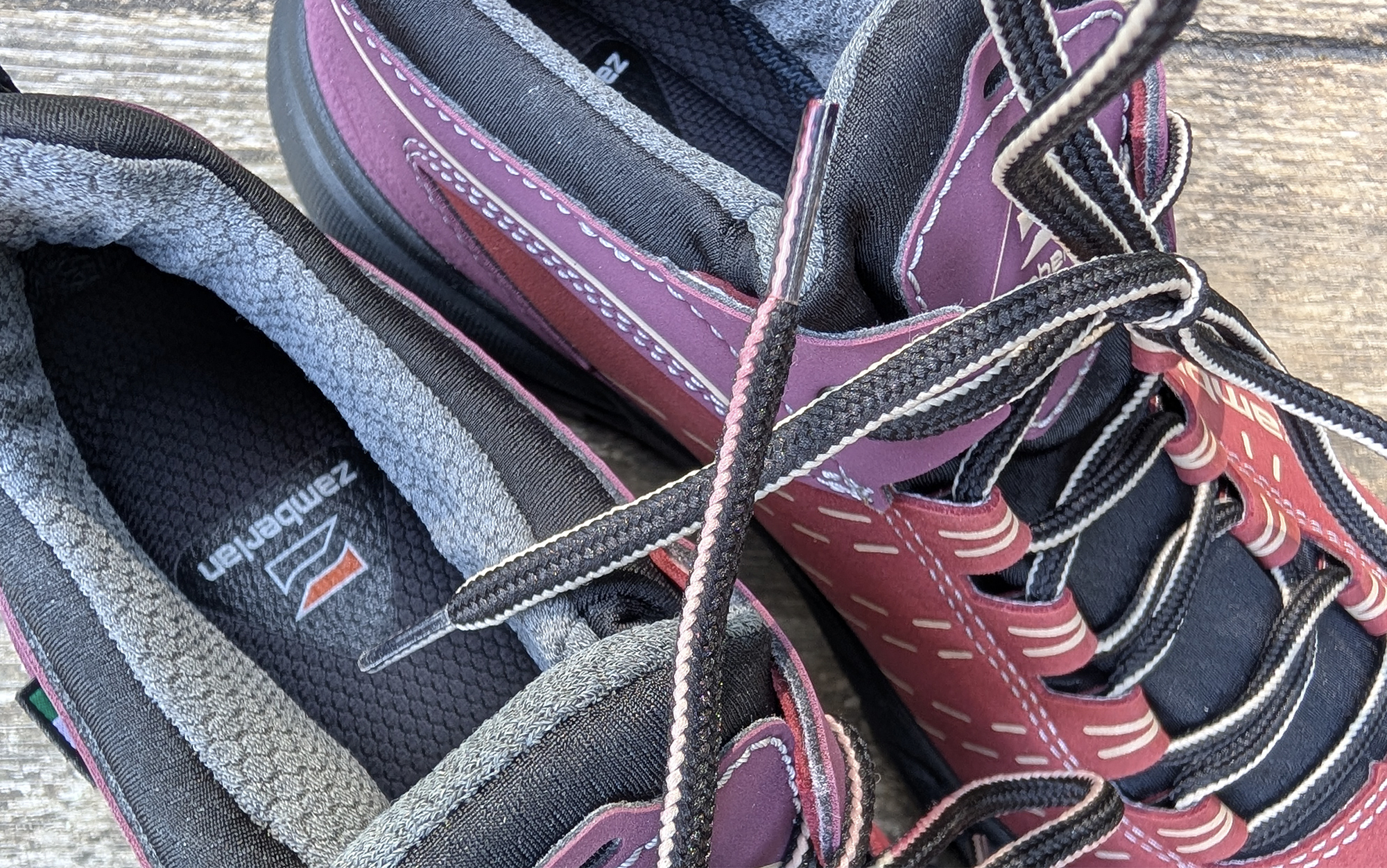
The Zamberlan Circe GTX also runs fairly narrow. Even my standard-width foot felt fairly constricted in it. This likely reflects Zamberlan’s European origins, as Europeans feet (and thus, the lasts that they build shoes off of) typically run narrower than Americans.
Meindl Power Walker Lady 3.0
Pros
- Fit should accommodate a wide variety of hikers
Cons
- Contains PFAS
- Took forever to dry
- More expensive than other options I looked at
Key Features
-
Available Sizes:
Women’s 6-10 -
Fit:
In-between -
Arch Support:
Low -
Runs true to size
Test Results
-
Price:
$190 -
Weight of One Shoe:
13.5 ounces -
PFAS free -
Soak Test:
Pass -
Dry Test:
65 hours
I was impressed after checking in with PR reps and scouring websites how well the outdoor industry has done in removing PFAS from their hiking shoes. PFAS is a group of chemicals used for waterproofing that, unfortunately, harm the environment. Thus, gear manufacturers like Gore-Tex have been working to remove it from their component parts, and some states (notably California and New York) have banned it from being sold in certain goods, including outdoor gear.
Unfortunately, the Meindl Power Walker Lady 3.0 was one of the shoes that is still using PFAS. While there is no known risk to human health from wearing shoes containing PFAS, PFAS can contaminate ground and drinking water during the manufacturing and disposal process. I do not recommend supporting the use of these chemicals in footwear. There are a lot of other great options on this list; I suggest picking one of those.
Fit of the Best Waterproof Hiking Shoes
I’m going to level with you: It’s always better to purchase a waterproof hiking shoe — or any footwear, really — after trying it on in person. That’s because footwear is designed around a “last” or foot-shaped mold, which can vary dramatically from brand to brand. However, I recognize that not everyone has access to a wide selection of waterproof hiking shoes to try on. To that end, I’ve provided relative notes below about the fit of each shoe compared to my own foot (a women’s size 9) that may be of help in making the choice for your foot. I evaluated:
- Size: Does the waterproof hiking shoe run true to size? I have noted when it ran small (meaning you should size up) or whether it ran narrower than an average size foot would find comfortable.
- Fit: There are basically two approaches to fit in footwear. The first is to lock the foot in a technical fit so that it stays exactly in place as you move throughout tricky terrain. The second is a more natural fit, which gives your toes room to splay, and your arch the ability to spread out and contract as you move through the gait cycle. Some shoes adhere strictly to one of these two poles, while others are more in-between.
- Arch Support: While the arch does not typically require support if properly trained and strengthened, some people prefer some arch support when out on longer hikes or with heavier packs. The amount of arch support that will feel comfortable to you depends on your arch shape. I have noted when each shoe had more or less arch support built into it. Keep in mind that someone who desires more arch support can always add one of the best insoles for hiking to their hiking shoe; however, do not purchase a waterproof hiking shoe with a high level of arch support if you have a low arch foot, as it will aggravate and annoy you.
| Waterproof Hiking Shoes | Price | Size | Fit | Arch Support |
|---|---|---|---|---|
| Asolo Space GV ML | $180 | True to size | Technical | Low |
| Danner Trail 2650 GTX | $190 | Runs small | Technical | Low |
| Hoka Anacapa 2 Low GTX | $180 | Runs slightly large | Natural | Low |
| La Sportiva Spire GTX | $210 | Runs slightly large | In-between fit | Medium |
| Meindl Power Walker Lady 3.0 | $190 | Runs true to size | In-between fit | Low |
| Merrell Moab Speed 2 GTX | $170 | Runs true to size | In-between fit | Low |
| Oboz Katabatic LT Low GTX | $145 | Runs true to size | Technical | Low |
| Oboz Sawtooth Low B-Dry Waterproof | $140 | Runs narrow | Technical | High |
| Salomon XA Pro 3D V9 GTX | $160 | Runs true to size | In-between fit | High |
| Zamberlan Circe GTX Low | $240 | Run narrow | Technical fit | Medium |
How I Tested the Best Waterproof Hiking Shoes
My focus on the best waterproof hiking shoes was, naturally, on how well its waterproofing worked. To determine this, I started by leaving each shoe in standing water that ran above the outsole (the soak test) for eight hours. At the end, I checked whether or not the interior of each shoe was still dry, giving a pass/fail grade as warranted.
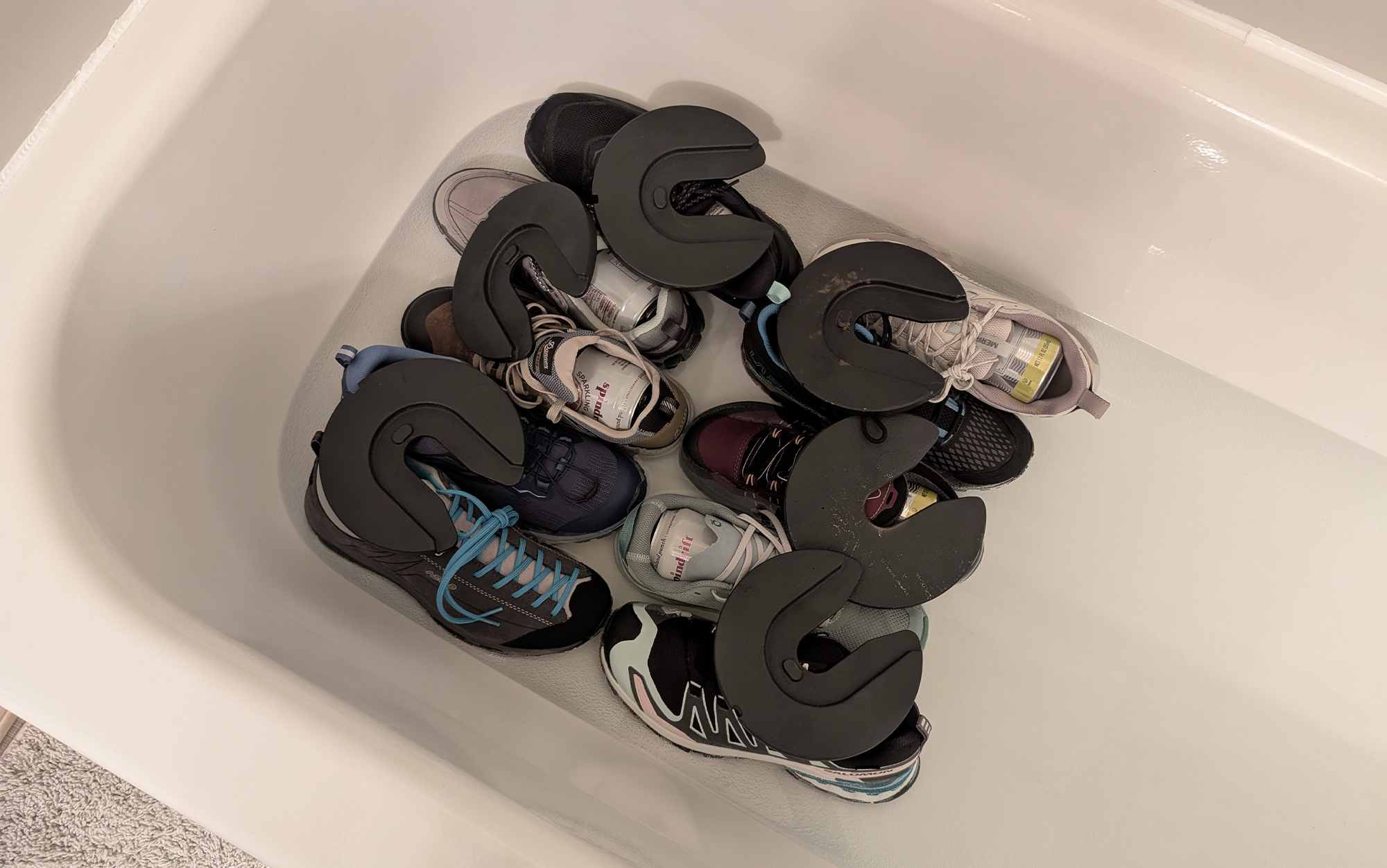
Of course, the corollary to keeping water out is that the best waterproof hiking shoes often do not breathe well enough to vent any sweat your feet are kicking up. To figure out the extent of this issue for each waterproof hiking shoe, I completely soaked each shoe, inside and out, and then left them in a room with 50 percent humidity to see how long they would dry (the dry test).
| Waterproof Hiking Shoes | Price | Weight | PFAS Free? | Soak Test | Dry Test |
|---|---|---|---|---|---|
| Asolo Space GV ML | $180 | 11.8 oz | Yes | Pass | 42 hours |
| Danner Trail 2650 GTX | $190 | 11.6 oz | Yes | Pass | 32 hours |
| Hoka Anacapa 2 Low GTX | $180 | 13.4 oz | Yes | Pass | 24 hours |
| La Sportiva Spire GTX | $210 | 14.0 oz | Yes | Pass | 42 hours |
| Meindl Power Walker Lady 3.0 | $190 | 13.5 oz | No | Pass | 65 hours |
| Merrell Moab Speed 2 GTX | $170 | 11.3 oz | Yes | Pass | 48 hours |
| Oboz Katabatic LT Low GTX | $145 | 11.5 oz | Yes | Pass | 46 hours |
| Oboz Sawtooth Low B-Dry Waterproof | $140 | 15.2 oz | Yes | Pass | 49 hours |
| Salomon XA Pro 3D V9 GTX | $160 | 12.6 oz | Yes | Pass | 34 hours |
| Zamberlan Circe GTX Low | $240 | 14.3 oz | Unavailable | Fail | 42 hours |
Additionally, I researched, reaching out to company reps when necessary, whether or not the waterproofing contained PFAS. PFAS, although common in waterproofing in recent years, is now understood to be contaminating waterways, where it is harmful to human health. I do not recommend purchasing waterproof hiking shoes that contain intentionally added PFAS.
Finally, I weighed one shoe from each pair, both before and after the waterproofing test, noting the weight and any additional weight each had accrued.
Things to Consider When Buying the Best Waterproof Hiking Shoes
PFAS in the Best Waterproof Hiking Shoes
In recent years, there has been growing awareness of the danger of PFAS, a class of chemicals used for everything from durability to stain resistance to waterproofing. These chemicals were especially prevalent in Gore-Tex gear. While there is currently no evidence that wearing outdoor gear containing PFAS harms human health, the production of these chemicals is implicated in a variety of human health concerns. (Gore-tex is currently dealing with a lawsuit brought on by residents near their Maryland facilities.) Thanks to new legislation out of California and New York, as well as retailer REI’s decision to ban it from certain items, PFAS is fast disappearing. While there may be some concerns about just how waterproof the new technologies are that replace PFAS, thus far my testing has shown that they are doing just fine. Choose footwear without PFAS whenever possible.
Water Retention of the Best Waterproof Hiking Shoes
The corollary to “waterproof” is “water retention.” There is forever a balance that must be found between keeping water out of your footwear, and trapping water inside (typically in the form of sweat). Consider what level of waterproofing, versus water resistance, you actually need before making a final purchase.
FAQs
Whether or not you choose waterproof hiking shoes is a matter of personal preference. If you live in an especially soggy part of the country, where muddy trails pockmarked with puddles is common, and keeping your feet dry is a top priority, then it will likely be the right choice for you. On the other hand, if you live in a hot and arid part of the country, waterproof hiking shoes may actually expose your feet to more moisture. That’s because waterproof hiking shoes typically prevent heat and sweat from wicking out of your shoe (even so-called breathable options).
While many people prefer hiking boots over hiking shoes for the additional support, the reality is that the flexible uppers on most hiking boots will not protect your ankle from rolling. (You would need to have a true stiff upper, such as you would see on a ski or mountaineering boot, for that.) What does protect your ankle from rolling is a properly fitting hiking shoe or boot that locks your heel in place so that it doesn’t move while you hike. Hiking boots do provide protection against inadvertently kicking yourself as you hike and keep debris out from inside your boot without the need for a hiking gaiter.
Most hiking shoes are labeled as waterproof at the point of purchase, but if you are trying to figure out if a hiking shoe you’ve had for a while is waterproof there are a couple of things to look for. The first is a tag attached to the outside of the upper—this is especially common with hiking shoes that are protected with Gore-Tex, but there are also other waterproofing technologies that may be advertised. Sometimes you may even just see a tag that says “waterproof.” The next is to check the underside of the tongue, where manufacturers will often include the shoe’s model code. You can then look this up on their website to see whether or not your hiking shoe includes waterproofing technology.
Hiking shoes typically cost anywhere from $100 to $200.
Hiking shoes are worth it for hikers on challenging terrain, but are not typically necessary for hikers on well-maintained single track. If you find that you’re insecure about your foot placement or that you are consistently slipping then the support and traction of a hiking shoe may improve your outdoor experience. Hiking shoes also typically last longer than traditional road shoes or even trail runners. However, if you are a casual hiker who sticks to popular trails that are well maintained and without challenging sections, then by all means feel free to stick with the ratty athletic shoes you already own.
Final Thoughts
If wet feet are keeping you from heading out into the backcountry during the shoulder season then it may be time to invest in a pair of one of the best waterproof hiking shoes. And if you already have a favorite brand of hiking shoe, then start your search by checking to see if the manufacturer makes a waterproof version of that shoe. If you’re starting your search from scratch then consider any of these picks.
The post The Best Waterproof Hiking Shoes of 2025, Tested and Reviewed appeared first on Outdoor Life.
Source: https://www.outdoorlife.com/gear/best-waterproof-hiking-shoes/

